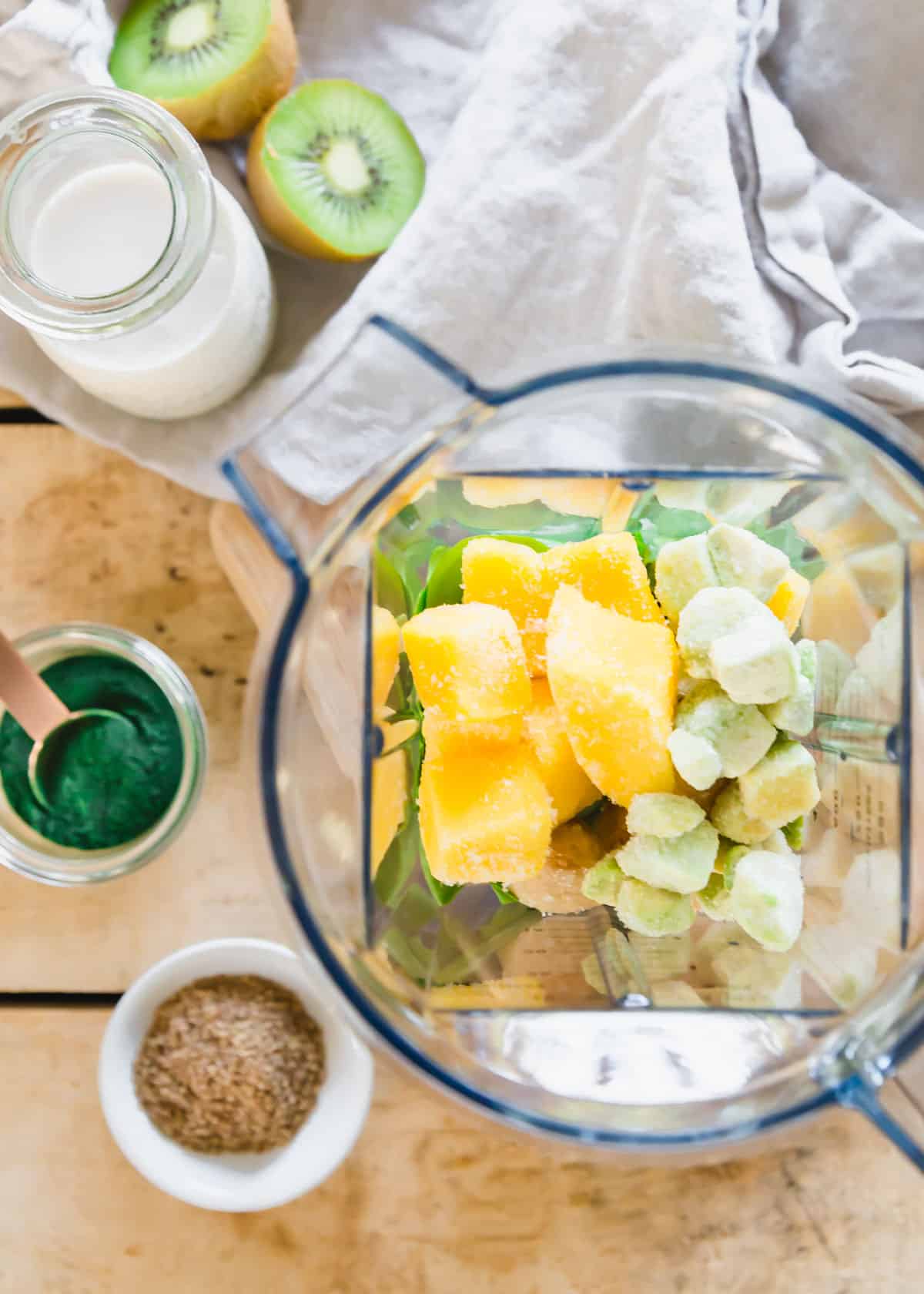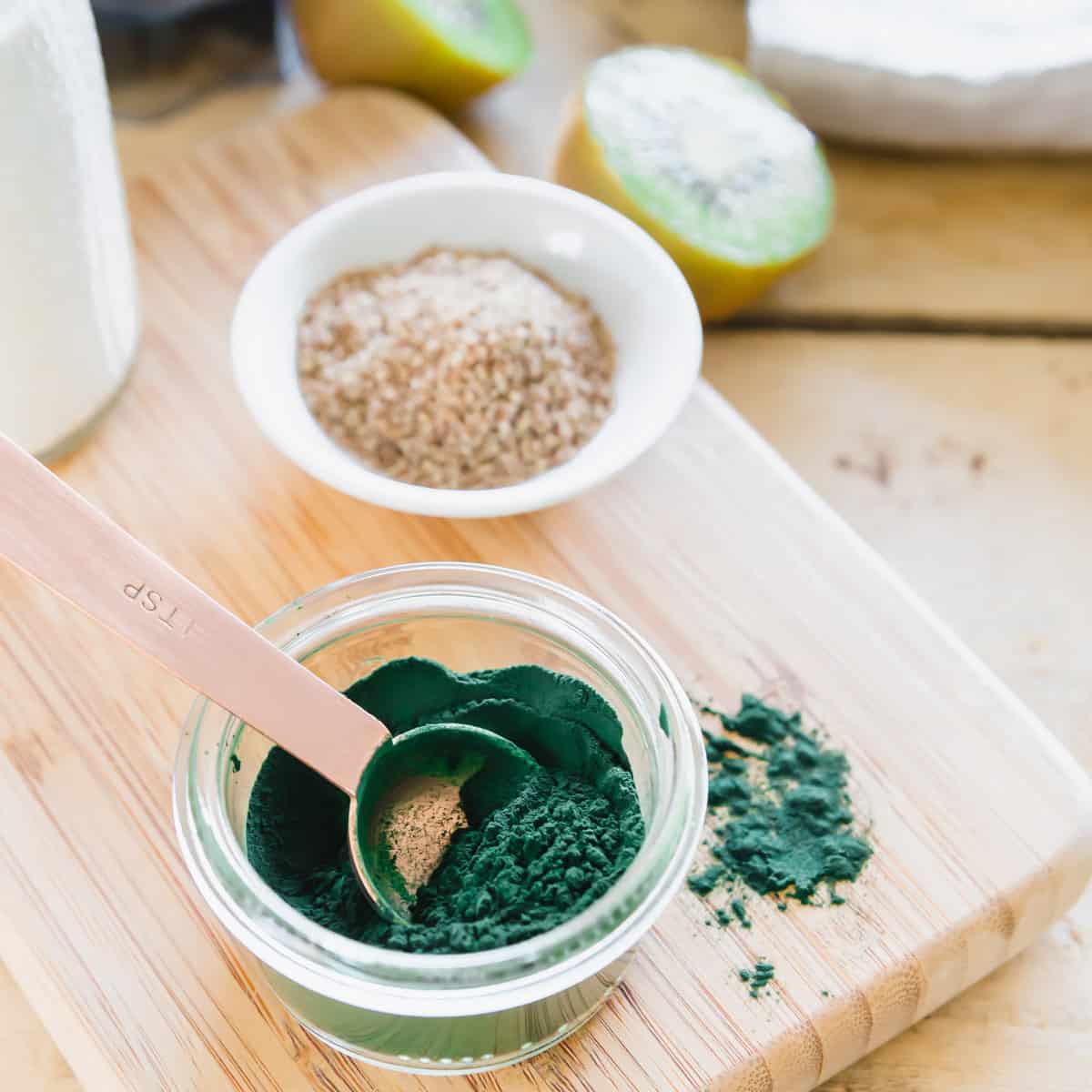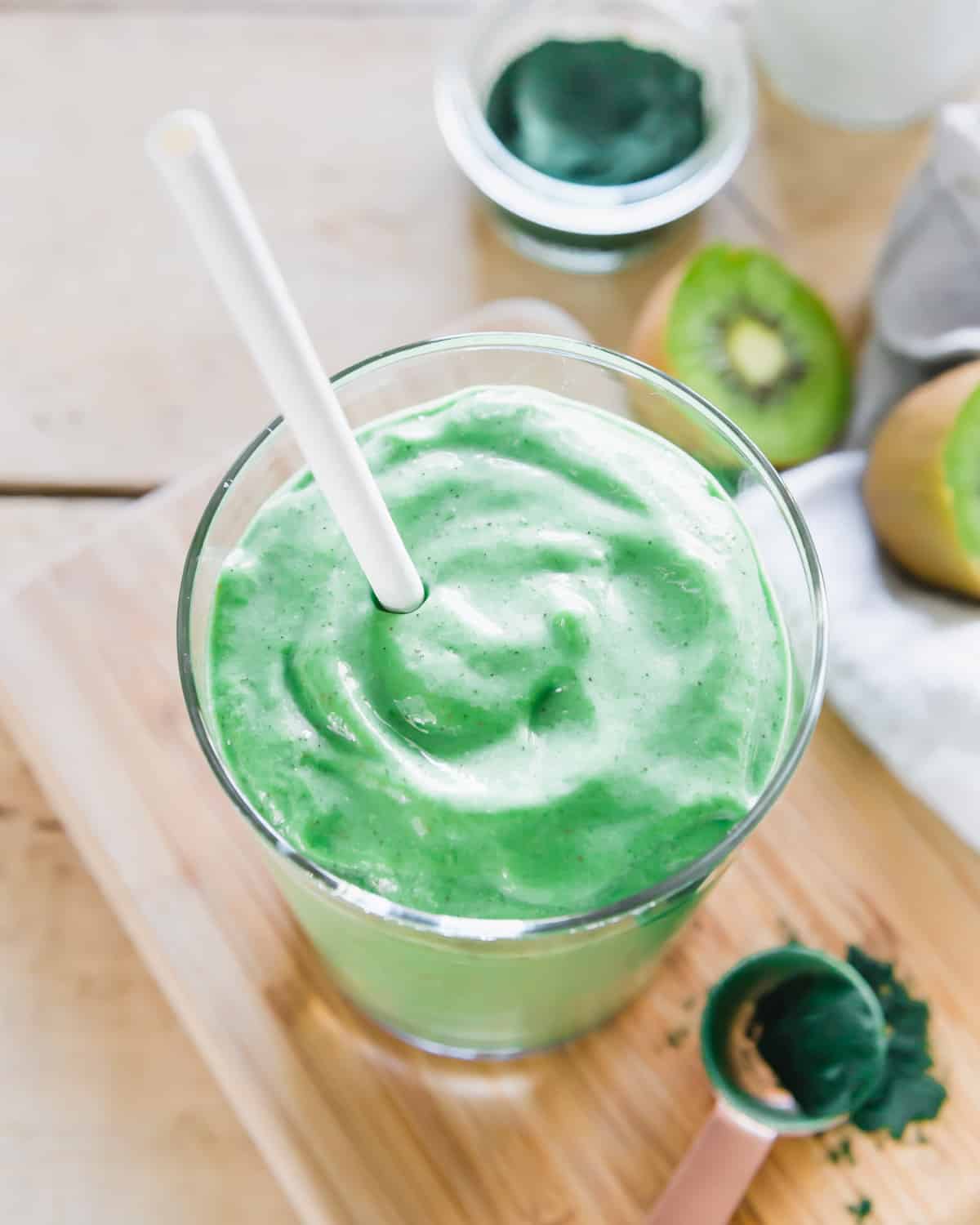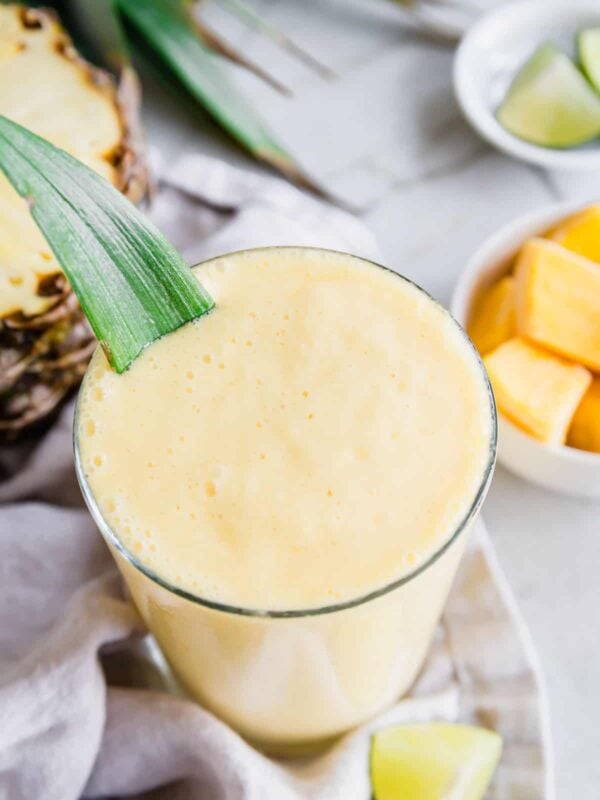This easy spirulina smoothie is packed with plant fiber and nutrients. It’s the perfect way to enjoy the popular blue-green algae in a delicious way. Mango and banana provide tropical flavor while spirulina, baby greens and avocado create an antioxidant powerhouse of a drink!

It doesn’t get more cliché than posting a salad (this bok choy salad) and now a smoothie the first week of January, does it?
I’m ok with it though because both are delicious ways to enjoy typical “resolution” foods that also happen to pack in some serious nutrition.
I’ve really gotten into smoothies for breakfast over the last 1.5 years. I now eat them religiously about 3-4x a week.
My Vitamix has gotten more use in the past 18 months than the 9 years prior that I’ve owned it!
I wrote an entire tutorial on how to make a healthy smoothie back in the day. All those steps and tips are still the foundation of my smoothie making process.
But, that doesn’t mean I’m not always on the lookout for a new addition. Particularly one that can amp up the health and nutrition of my smoothie.
Recently, spirulina powder has become my newest favorite find.
I love using it as a base to make spirulina smoothies with a rotating assortment of greens and fruits.

WHAT IS SPIRULINA?
Spirulina is an incredibly nutritious blue-green algae known as a cyanobacteria.
It’s regarded as a superfood similar to chlorella and used primarily as a supplement for humans and animals.
There are two species of spirulina: arthrospira platensis and arthrospira maxima, grown in both fresh and salt water.
Spirulina dates back to the Aztecs but became popular a few decades ago with NASA scientists proposed using it in space for astronauts (source).

WHAT ARE THE HEALTH BENEFITS OF SPIRULINA?
Spirulina is high in B vitamins (although not B12 since the type provided is not well absorbed by humans) and a complete protein source meaning it contains all the essential amino acids. 1 tablespoon of spirulina powder provides 4g of protein.
It’s most known for its powerful antioxidant and anti-inflammatory properties.
Phycocyanin is the main active component in spirulina and responsible for the trademark vibrant blue-green color.
It’s what fights the free radicals (also known as cancer-fighting) and inhibits the production of inflammatory signaling molecules in the body (source).
There are many other validated health claims that spirulina provides, including:
- lowering LDL cholesterol and triglyceride levels
- potentially lowering blood pressure through the increase of nitric oxide production (source)
- helping to boost metabolism, muscle strength and endurance
- aid in blood sugar control
- protective against anemia
As you can see, spirulina is no slacker when it comes to health benefits!

WHAT DOES SPIRULINA TASTE LIKE?
To be honest, eaten alone or as the main component in a drink, it’s not the most pleasant taste.
It has a strong seaweed/lake undertone mixed with the earthiness of grass. Yum, right?
That said, a little goes a long way and the somewhat unpleasant flavor is easily masked with other ingredients in a smoothie.
So don’t be alarmed when you smell it for the first time!
HOW MUCH SPIRULINA POWDER SHOULD I USE?
Not much at all! Anywhere from 1/2 – 1 teaspoon for a single serving is plenty in a smoothie.
I recommend starting off on the lower end and increasing from there once you have some experience with it and how the flavor comes through in different applications.
This spirulina smoothie recipe makes 2 small to medium servings and I used 1 teaspoon of spirulina total.
Of course, this is completely customizable to your preference. So if you’re not bothered by the taste, feel free to use the higher end of that range or even a little more.

WHICH SPIRULINA BRAND IS BEST?
Like most supplements, there’s no shortage of options and brands when it comes to choosing a spirulina powder.
I don’t have a particular brand that I like best but do your research and make sure whichever spirulina brand you choose holds itself to high standards when it comes to third party testing.
You can always ask to see the COA (certificate of authenticity) from any brand to confirm things like levels of heavy metals, etc.
If this isn’t posted on a brand’s website and they refuse to share it with you when asked, my suggestion is to stay away from that particular brand.
That sort of request is not proprietary information (an often stated response) and everyone should have a right to know what they’re putting in their own body.

BLUE SPIRULINA VS. GREEN SPIRULINA
You may have seen those crazy colored (almost unicorn like) blue smoothies out there touting “blue spirulina” as the main ingredient.
To get this blue color, the aforementioned antioxidant, phycocyanin is extracted from the spirulina.
Phycocyanin is what gives the spirulina its corresponding blueish tint.
So when it’s extracted to stand alone from the rest of the spirulina, its appearance is a very vibrant blue color.
It’s then sold as “blue spirulina” and how you get blue colored spirulina smoothies.
Here’s the thing though, nutrients and such are always more effective when absorbed synergistically in the package they come in naturally.
When you remove just one nutrient from a food, like the phycocyanin in this case, you lose that synergistic effect.
It’s for this reason that I choose to buy green spirulina (which is really just the “normal” or “whole” version) and use that when making my spirulina smoothies.

HOW TO MAKE THE BEST GREEN SPIRULINA SMOOTHIE
Like most smoothie recipes, this one is as easy as they come. All the ingredients are just tossed in a blender and blended until smooth and creamy.
It’s not about the method in this case, it’s about the ingredients.
You’ll need the following ingredients to make this easy spirulina smoothie:
- baby greens (I use a mix of spinach, kale & arugula usually)
- frozen mango
- frozen banana
- cucumber or frozen zucchini
- frozen avocado
- kiwi
- ground flax seed
- spirulina powder
- milk of choice or a milk/water blend
- protein or collagen powder of choice (optional)
The result is a super creamy, gorgeous green colored smoothie with tropical flavored undertones.
As I mentioned earlier, masking the somewhat strong “seaweed” taste of spirulina is key to enjoying this superfood. Mango, banana and kiwi do a wonderful job of that in this smoothie. If you can’t get behind the green taste of spirulina, just make this mango pineapple smoothie instead.
While I enjoy many different smoothies using spirulina powder, I tend to prefer ones that use a tropical fruit like mango or pineapple. I find they disguise the spirulina flavor better than berries.
The avocado is responsible for the creaminess (just like in this pineapple avocado smoothie bowl), while the flax brings some additional healthy omega-3 fats.
The cucumber/zucchini and baby greens bring gut-loving plant fiber.
Protein or collagen powder (if used) round out the macro nutrients to make this smoothie not only insanely nutritious but also a spirulina smoothie that tastes good!
If you choose to omit the protein powder or collagen, you can add some hemp seeds (as shown) or chia seeds instead for an extra protein boost.
It’s a plant-based, dairy-free (assuming a plant-based milk or water is used), gluten-free and vegan smoothie that’s great as a healthy snack or breakfast just like this pumpkin papaya gut healing smoothie.
The vibrant green color would make it a great option for St. Patrick’s Day along with these green oats!

MORE SMOOTHIE RECIPES TO TRY:
Roasted Apricot Green Smoothie
Easy Tropical Spirulina Smoothie

Equipment
Ingredients
- 1 cup baby greens, spinach, kale, arugula, etc.
- 3/4 cup frozen mango chunks, or pineapple
- 1/2 cup frozen banana
- 1/2 cup cucumber or frozen zucchini
- 1/4 cup frozen avocado chunks
- 1 kiwi
- 1 tablespoon ground flax seed
- 1/2 – 1 teaspoon spirulina powder
- 1 cup unsweetened almond milk or water, *see note
- 1 scoop protein powder/collagen of choice, optional
Instructions
- Combine all ingredients in a high-powered blender such as a Vitamix and blend until smooth and creamy.
- Pour into glasses or a bowl and enjoy as is or with your favorite smoothie bowl toppings (shown with hemp hearts)
Notes
Nutrition
Nutrition information is automatically calculated, so should only be used as an approximation.
Gina Matsoukas is an AP syndicated writer. She is the founder, photographer and recipe developer of Running to the Kitchen — a food website focused on providing healthy, wholesome recipes using fresh and seasonal ingredients. Her work has been featured in numerous media outlets both digital and print, including MSN, Huffington post, Buzzfeed, Women’s Health and Food Network.










This smoothie was SOOO refreshing! I love how the flavors play out in every sip! Such a great recipe to try!
A perfect way to start your day. Very delicious, healthy and satisfying!
I made this for breakfast this morning, and it will definitely go on my regular rotation. The mango and banana gave it such a nice fruity flavor, and it kept me full and satisfied all morning.
This is such a great smoothie. The pineapple and spirulina flavors are so good together! I love how you add in the banana too. It gives it just a bit of sweetness, but not too much. The only thing that could make this better would be if there were some ice cream in it!
I loved how the flavours of the mango and banana helped the spirulina be just a little covered. It tasted great and I felt energetic during my morning workout after I had this smoothie.
Yes! Thank you for the suggestions! I’ve been adding Spirulina to a few different combinations of fruits & veggies, but could still taste too much “pond”. I totally agree that banana & pineapple do the best job of masking the flavor. Specifically I used: half fresh banana, 1 t of pineapple juice concentrate, 1 frozen apricot, 1 t Spirulina, 1 t MCT oil, and about 4-6 oz of organic soy milk. Poured over ice cubes – delicious! 35g carbs, 7.3 g fat, 8 g protein. Next time I’ll try frozen pineapple in place of concentrate, and a T of hemp seeds in place of MCT.
Healthy and simply delicious! Can’t wait to try this one.